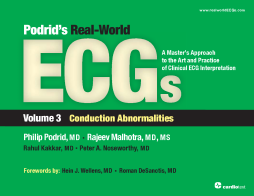
BOOK
Podrid's Real-World ECGs: Volume 3, Conduction Abnormalities
Philip Podrid | Rajeev Malhotra | Rahul Kakkar
(2013)
Additional Information
Book Details
Abstract
Podrid's Real-World ECGs combines traditional case-based workbooks with a versatile Web-based program to offer students, health care professionals, and physicians an indispensable resource for developing and honing the technical skills and systematic approach needed to interpret ECGs with confidence. ECGs from real patient cases offer a complete and in-depth learning experience by focusing on fundamental electrophysiologic properties and clinical concepts as well as detailed discussion of important diagnostic findings and relevant management decisions. Six comprehensive volumes encompass more than 600 individual case studies—plus an online repository of hundreds more interactive case studies (www.realworldECGs.com)—that include feedback and discussion about the important waveforms and clinical decision-making involved. From an introductory volume that outlines the approaches and tools utilized in the analysis of all ECGs to subsequent volumes covering particular disease entities for which the ECG is useful, readers will take away the in-depth knowledge needed to successfully interpret the spectrum of routine to challenging ECGs they will encounter in their own clinical practice.
Dr. Philip Podrid, the primary author, is an academic cardiologist and Professor of Medicine and Pharmacology at Boston University School of Medicine and a Lecturer at Harvard Medical School. He has taught ECG interpretation for more than 35 years to medical students, house staff (interns and residents), cardiology fellows, physicians, nurses, and EMTs.
Volume 3, Conduction Abnormalities, (101 cases) explores the essentials of AV nodal and intraventricular conduction abnormalities seen in everyday clinical practice:
AV conduction abnormalities, including first-, second-, and third-degree AV block and enhanced AV conduction
Intraventricular conduction abnormalities, including intraventricular conduction delay, fascicular block, and bundle branch blocks.
This is a well-written, easy-to-read book on ECGs, particularly conduction abnormalities, for those just learning the material, such as students, and those who need to develop a deeper understanding. It provides useful examples and explanations in real-life scenarios of patient care, making it an ideal instructional book. - Doody Review (Paul Rogers, MD, PhD)
